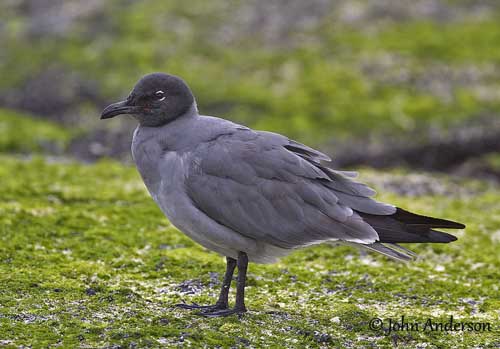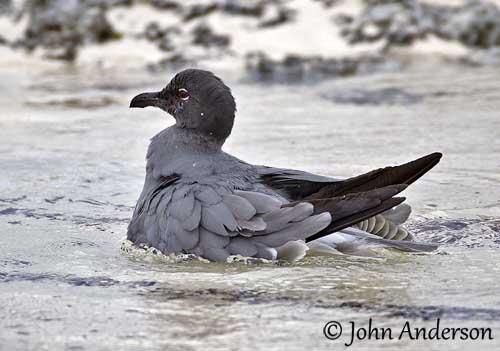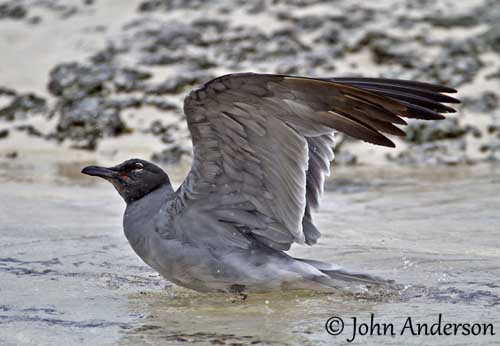
Fr: Mouette obscure
All : Lavamöwe
Esp : Gaviota Fuliginosa
Ital : Gabbiano fuligginoso
Nd: Lavameeuw
Sd: Lavatrut
Photographer:
John Anderson
John Anderson Photo Galleries
Text by Nicole Bouglouan
Sources:
HANDBOOK OF THE BIRDS OF THE WORLD Vol 3 by Josep del Hoyo-Andrew Elliott-Jordi Sargatal - Lynx Edicions - ISBN : 8487334202
BirdLife International (BirdLife International)
Lava Gull
Leucophaeus fuliginosus
Charadriiforme Order – Laridae Family
BIOMETRICS:
Length: 51-55 cm
Wingspan: 130 cm
DESCRIPTION:
The Lava Gull is endemic to Galapagos Islands where only 300-400 pairs are living on all year round. This species is the world’s rarest gull.
The name “lava” derives from the plumage colour similar to the lava rocks of their preferred habitats.
The adult has sooty-grey body with paler grey belly, whereas wings are darker grey with blackish primary-coverts and flight feathers. The tail is pale grey with darker central rectrices. Upper and undertail-coverts are whitish.
The head is blackish or sooty-brown. We can see the white eyelids contrasting strongly against the dark head. Gape and inside of mouth are bright red.
The bill is black, with sometimes red tinge at tip. The eyes are dark brown with narrow red eyering. Legs and webbed feet are brownish or purplish-black.

Both sexes are similar. They have brighter plumage and bare parts during the breeding season.
The juvenile is mostly dark brown with pale rump.
The 1st year usually shows dark hood and some grey tinge on mantle. It needs three years to acquire the full adult plumage.
VOICE: SOUNDS BY XENO-CANTO
The Lava Gull often gives long raucous calls while body and head are held almost horizontally and the bill wide open. The sounds are variations of harsh croaking and screaming notes.
Contact, feeding behaviour, courtship and threat displays are usually accompanied by loud calls.
HABITAT:
The Lava Gull is found on desert islands, on sandy and gravelly beaches. They may frequent harbours and wander around the boats.
This species nests in sheltered sites near calm water, but close to the sea.
RANGE:
The Lava Gull is resident on the Galapagos Islands and relatively common in bays and lagoons of Puerto Ayora on Santa Cruz Island.
BEHAVIOUR:
The Lava Gull feeds on various food items such as small fish and crustaceans, eggs of seabirds, offal and scraps. Baby marine iguanas are caught too. This species is known for eating the placentae of sea lions too.
It scavenges close to the fishing boats, in harbours and near human settlements.

The Lava Gull usually feeds along the shore from which it flies along at some metres to search for food. It does not fly far from the shore. It is rarely seen settled on sea, and prefers to perch on rocks, boats and piers. It hovers over the surface to take some floating offal or food item. It may pirate crabs from Lava Herons.
Unlike other Laridae species, the Lava Gull nests solitary in sheltered places near coastal lagoons. Its territory is large, established on sandy beach or low outcrop and always close to the water. This species breeds throughout the year.
Like in all Laridae species, courtship displays are performed in order to enhance the head pattern and the dark plumage. The typical behaviour on which they often engage shows the bird performing downwards head-bobbing followed by loud sound, similar to human laughter.
The Lava Gull does not migrate but may disperse up to 25 km from the nesting areas.
FLIGHT:
The Lava Gull has long wings and flies easily, although it does not move frequently.
REPRODUCTION:
The Lava Gull breeds all year round, with peak between May and October.
This species nests solitary within a large territory, in sheltered places near calm water but close to the sea. The nest is a scrape on the ground.
The female lays two heavily marked olive eggs. This cryptic colour makes them invisible on sands or gravels. Incubation by both parents lasts 30-33 days. The young fledge about two months after hatching. They still depend on parents for three weeks more after fledging.
This species is wary when nesting, and often leaves the nest if an intruder is approaching.

DIET:
The Lava Gull feeds on small fish, crustaceans, baby marine iguanas, eggs of seabirds, offal and scraps.
It can be seen around boats and piers where it can find offal.
PROTECTION / THREATS / STATUS:
The Lava Gull is the world’s rarest gull, only living on Galapagos Islands where there are about 300-400 pairs.
This species is threatened, due to very small populations scattered on desert islands. However, their habitat is protected, but it also suffers increasing pressure due to various exploitation and human disturbance.
The Lava Gull is currently considered VULNERABLE by BirdLife International.